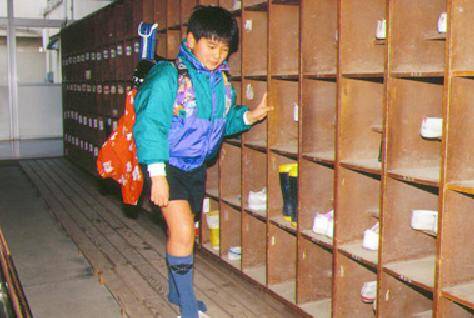
Figure 1.-- This boy has just arrived at school and is putting on his slippers or uwabaki. He then puts his outdoor shoes in his locker or Getabako. |

|
Another garment worn at schools are slippers. We think that they are worn at virtually all schools. We are not sure if slippers is the best English-language term. Perhaps we should say soft or indoor shoes. The Japanese term is "uwabaki"
I an not sure just when they were introduced. When the children arrive at school, they take off their shoes and put on slippers. This is a common practice in the home as well and of course helps to keep the school clean. As far as we know the slippers are not uniform styles. We see children at some uniform schools with different uwabaki. Some schools may have established uniform styles and colors that are acceptable, but we have no details at this time. Perhaps that many uwabaki are standard enough that many schools have not found this nececessary. There are, however, some differebnces anong uwabaki. We see children wearing a wide range of colors and styles. They are worn at both uniform and non-uniform schools. The children have their designated shoe lockers; like the shoe lockers in houses. These shoe lockers are called getabako.
Another garment worn at schools are slippers. We think that they are worn at virtually all schools. When the children arrive at school, they take off their shoes and put on slippers. Japanese schools normally do not have the tatami mats that are common in houses. Even so, the children take off their shoes before entering, just as is expected in a house. This is a common practice in the home. This is a matter if clkeanliness. We note a simiklar practice in Germany, although not at schools. This helps to keep the school and home clean. We believe that earlier the children wore stockings are barefeet. Stockings are, however, a little dabgerous on slippery floors. The uwabaki have treadded rubberized soles. Yhis porivides a more stable footing even on smooth, slippery floors.
We are not sure if slippers is the best English-language term. Perhaps we should say soft or indoor shoes. The Japanese term is "uwabaki".
I an not sure just when uwabaki were first introduced. We believe that before Woirld War II that may children may havce just wirn hosiery t school. We can not, however, confirm this at this time.
Uwabaki are worn at both uniform and non-uniform schools. As far as we know the slippers are not uniform styles, at least at the non-uniform schools. We see children at some uniform schools with different uwabaki, but at others they seem to be wearing the sane style. Some schools may have established uniform styles and colors that are acceptable, but we have no details at this time.
Perhaps that many uwabaki are standard enough that many schools have not found it nececessary to chose a specific style. There are, however, some differences anong uwabaki. We see children wearing a range of colors and styles. White or light colored Uwabaki seem the most common. Some have colored highlights. We are not entirely sure about styles as our rchive is still fairly limited. The two basic styles seem to be Uwabaki done like strap shoes/ballet slippers. Others are done more like sneakers, although without laces. They are elkasticzed as aay of keeping them on. As they are not outdoor footwear used for strenous sports, they do not strong fastening to keep on.
We note styles of Uwabaki that seem to have gender connotations. For example the Uwaabaki done like strap shoes.ballet slippers seem more popular for the girls than fir the boys, although our archive uis fairly limited so we are not ebtirely sure about that. We do not yet know how many schools that require specufic styles ave different styles foir boys abd girls ir how many of the schools have the same styles. Hipefully our Japanese readers will priovide some insights here.
A reader writes, "I am uncertain whether they wear school socks with the shoes but that is probably the reason that shoes are not uniform (because school shoes are uniform) If the boys wear long pants then the socks are not visible so it would not matter which may explain why it is different. However, that would not explain sock variation with shorts." We believe that the children keep their socks on that they wore to school. We could be wrong bout this
The children have their designated shoe lockers; like the shoe lockers in houses. These shoe lockers are called getabako. Here they place their street shoes abd put on their Uwabaki which are kept in the lockers.
Uwabaki are only for the children. The teachers do not wear them. Teachers wear shoes. This does not mean they wear their street shoes. Rather when they arrive at school they take off their street shoes and put on a special pair of shoes kept sat school abnd are only worn there inside cthe dchool building.
Navigate the Relate Boys Historical Clothing Uniform Garment Pages
[Main Japanese non-uniform school garment page]
[Main Japanese school footwear page]
[Main Japanese school garment page]
[Main garment page]
[Blazers]
[Bookbag]
[Caps]
[Coats]
[Hose]
[Kilts]
[Pants]
[Shirts]
[Shoes]
[Smocks
[Suits]
[Seaters]
[Ties]
Navigate the Boys' Historical Clothing School Uniform Country Pages
[Main School Uniform Page]
[Main National School Uniform Page]
[Australia]
[England]
[France]
[Germany]
[Ireland]
[Italy]
[Japan]
[New Zealand]
[Poland]
[Singapore]
[Scotland]
[Singapore]
[United States]
Navigate the HBC chool Section:
[About Us]
[Activities]
[Chronology]
[Clothing styles]
[Countries]
[Debate]
[Economics]
[Garment]
[Gender]
[Hair]
[History]
[Home trends]
[Literary characters]
[School types]
[Significance]
[Transport and travel
[Uniform regulations]
[Year level]
[Other topics]
[Images]
[Links]
[Registration]
[Tools]
[Return to the Historic Boys' School Home]
